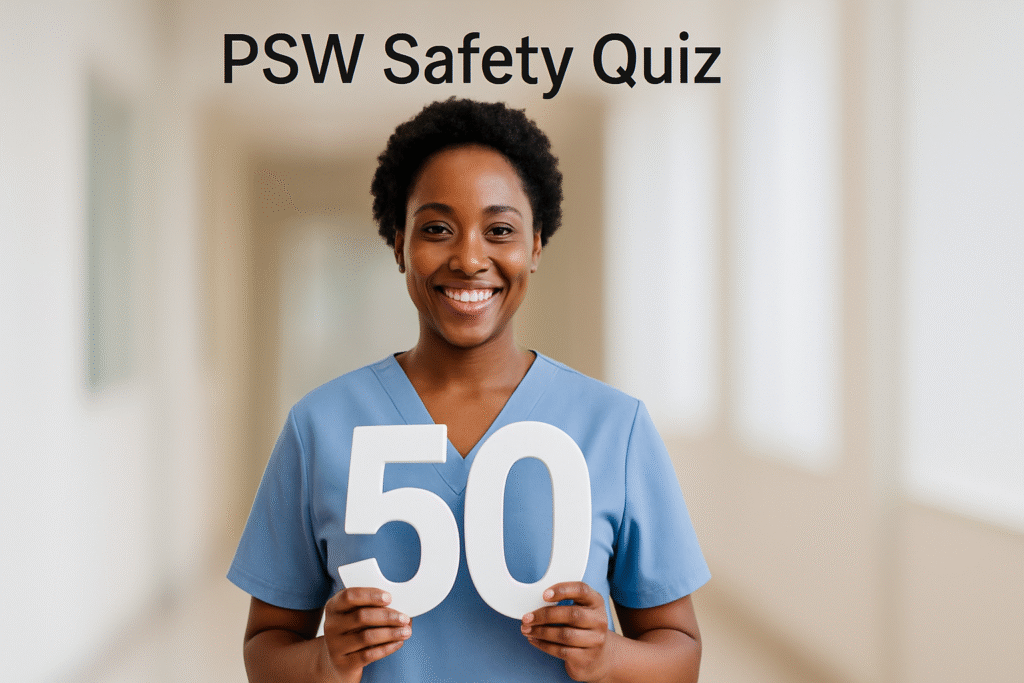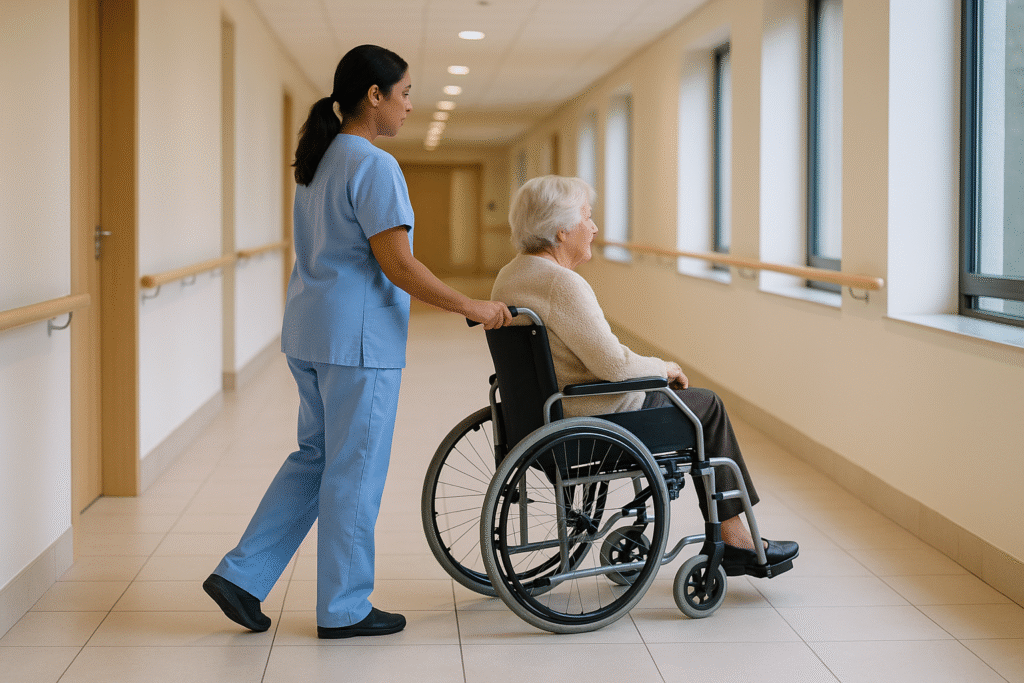Welcome to the PSW Safety Quiz. This 50-question checkup helps Personal Support Workers refresh critical safety practices—from hand hygiene and PPE to transfers, WHMIS, documentation, and client privacy.

PSW Safety Quiz
Choose the best answer for each question, then submit to see your score, clear explanations, and a downloadable CSV of your results for training records.
Personal Support Worker safety knowledge check. Choose the best answer for each question. No account or tracking; results stay in your browser.
Results
Well done—you’ve completed the PSW Safety Quiz. Use the review to study any missed questions and note the “why” behind each correct answer; those rationales connect policy to practice.
If your score fell below your team’s benchmark, revisit key areas like hand hygiene, PPE donning/doffing, safe transfers, WHMIS/SDS basics, and objective documentation. Bring any uncertainties to your supervisor or educator, and update your personal learning plan.
Record your results for your training file, repeat the quiz after practice or coaching, and set a reminder to retake it monthly or after policy updates.
Consistent refreshers, near-miss reporting, and speaking up about hazards keep you, your coworkers, and your clients safer—every shift.
PSW Safety is the everyday discipline that keeps you, your coworkers, and your clients protected—whether you work in long-term care, home care, retirement, or hospital units.
It’s not one policy or one poster; it’s a mindset you bring to bathing, feeding, transfers, cleaning, documentation, and emergencies. This guide translates standards into practical, shift-ready actions you can apply today.
PSW Safety starts with a three-step habit: Pause, Assess, Act
Before every task, pause to scan for hazards (wet floors, cords, aggressive behavior, oxygen equipment). Assess the client’s current condition, your body position, and whether you need help or devices.
Act using the right method—proper PPE, safe grip on a transfer belt, brakes locked on wheelchairs, and the bed at hip height. This 5-second habit prevents most incidents before they begin and anchors PSW Safety in routine.
Internal resource suggestions: take the PSW Safety Quiz to spot your blind spots (/psw-safety-quiz) and download the Safe Transfer Checklist to review before lifts (/safe-transfer-checklist).
Infection Prevention & Control: the frontline of PSW Safety
Hand hygiene remains the #1 control. Perform it at the “4 Moments” (before client contact; before clean/aseptic tasks; after body fluid exposure risk; after client/environment contact).

Keep surfaces visibly wet for the full disinfectant contact time—wiping too soon reduces effectiveness.
Match PPE to risk: medical mask and eye/face protection for droplet exposure; fit-tested N95 for airborne precautions or as indicated by your risk assessment and policy.
Review routine practices at least quarterly and refresh your technique with credible guides from Public Health Ontario and the World Health Organization.
Safe Handling & Mobility: the backbone of PSW Safety
Most injuries come from awkward lifts, twists, and rush. Use transfer belts correctly (underhand grasp at the sides/back), lock wheelchair brakes, remove or swing away footrests, and cue the client to help if able. For two-person moves, decide roles, clear obstacles, and use a verbal count (“On three”).
Avoid twisting: pivot with your feet and keep loads close to your body. If equipment is frayed or unstable, tag it Do Not Use, remove it from service, and report it immediately.
For deeper ergonomics guidance, see CDC/NIOSH Safe Patient Handling and the Canadian CCOHS ergonomics pages.
Medication Assistance & Documentation: precision is PSW Safety
Stay within scope and delegation. Never change doses or crush tablets unless the care plan explicitly says so.

Document objectively: who, what, when, where, and how (for example, “Client refused morning meds at 08:30. RN notified. Reason stated: nausea.”).
If a competent client refuses, respect the decision, document, and report—do not mark it “done” to stay on schedule.
For privacy, keep screens locked, charts out of public view, and conversations away from elevators, hallways, or social media.
Chemical & Cleaning Hazards (WHMIS): labels, SDS, and no mixing
Under WHMIS, read labels and Safety Data Sheets (SDS) before use. Wear the PPE listed, ventilate as required, and never mix chemicals—bleach and ammonia can create toxic chloramine gases.
Ensure workplace labels include the product name, safe-handling information, and an SDS reference. Dispose of blood-soaked items in red bag/biohazard waste as per policy; bag soiled laundry at point of use and avoid shaking.
Refresh with the Canadian Centre for Occupational Health and Safety and your provincial guidance. For Canadian OHSE articles and tools, see OHSE.ca.
Violence & Aggression Prevention: calm presence is PSW Safety
Use trauma-informed, de-escalation approaches: calm tone, open body language, non-threatening distance, and an exit path.
Avoid blocking the person’s way. If you note triggers (pain, confusion, overstimulation), address them early—offer a break, reduce noise, or involve the nurse.
Know how to summon help (call bell, code words, duress devices), and document early warning signs so the whole team can respond consistently.
Home & Community PSW Safety: road, pets, oxygen, and layouts
Between clients, only use your phone when safely parked.
On site, ask for pets to be secured before care, clear clutter and throw rugs, and check lighting. If oxygen is used, keep it at least two meters (six feet) from flames and heat sources, avoid petroleum products around the cannula, and post “No Smoking” reminders.
Plan room layouts so you can work at hip height and pivot freely without twisting.
Seasonal & Environmental Controls: heat, cold, and indoor air
Heat exhaustion often begins with heavy sweating, dizziness, and fatigue; move the person to a cooler area, offer fluids if permitted, and escalate if symptoms progress.
Cold stress shows up as intense shivering and numb fingers; add dry, insulating layers, protect extremities, and warm gradually. Maintain fridges at 4 °C / 40 °F or below for food safety, and follow scent-free policies to protect sensitive clients and coworkers.
For weather-triggered work–rest guidance, consult your local public health and employer policies.
Mental Health & Fatigue: caring for the carer
Burnout and compassion fatigue can sneak up as irritability, detachment, and exhaustion. Build micro-rest habits (two deep breaths between rooms, sip water, gentle shoulder rolls).
Debrief tough shifts with a colleague or supervisor, use your employee assistance resources, and capture near-misses so the system—not only the worker—improves. Protect sleep: consistent bedtimes, a dark room, and device-free wind-downs matter when you’re on rotating shifts.
Responsibilities: employer and worker roles in PSW Safety
Employer responsibilities include providing safe equipment, training (e.g., transfers, WHMIS, IPAC), fit-testing for respirators where required, and clear policies for incident reporting, sharps injuries, and violence prevention.
Employee responsibilities include following training, wearing PPE, reporting hazards and near-misses quickly, using equipment as intended, and participating in refresher education.
Use your Joint Health and Safety Committee (or representative) to escalate recurring hazards and track corrective actions. If a process repeatedly forces shortcuts, raise it—PSW Safety improves when systems are fixed, not when workers keep compensating.

Quick, Repeatable Checklist for PSW Safety
- Identify the client with two identifiers; review the care plan before tasks.
- Prepare the environment: brakes locked, clutter cleared, footrests out of the way, bed at hip height.
- Protect with routine practices: perform hand hygiene at the 4 Moments and match PPE to the task.
- Move with good mechanics: transfer belt grip, pivot with your feet, ask for help or equipment.
- Label/Read chemicals and SDS; never mix products; respect contact times.
- Communicate calmly; use de-escalation strategies and know how to summon help.
- Document objectively and promptly; report hazards, near-misses, refusals, and privacy incidents.
- Reflect after the shift: what went well, what nearly went wrong, what will you change tomorrow?
Where to learn more
- Public Health Ontario – Routine Practices & Additional Precautions: https://www.publichealthontario.ca
- CCOHS – Ergonomics & WHMIS resources: https://www.ccohs.ca
- CDC/NIOSH – Safe Patient Handling: https://www.cdc.gov/niosh/topics/safepatient
- Your provincial ministry of labour and local policies for specific legal requirements.
Alongside these, explore your site’s internal resources such as PSW Safety Quiz (/psw-safety-quiz) and WHMIS for PSWs (/whmis-for-psws) to keep competencies fresh.


No comments yet